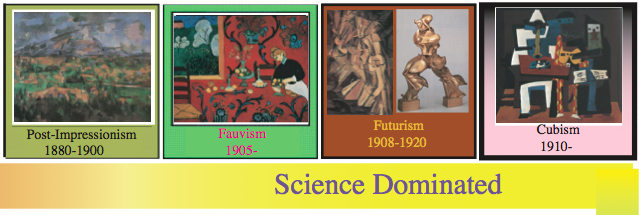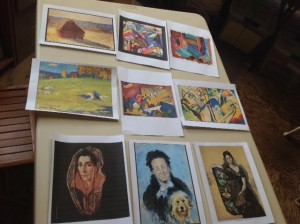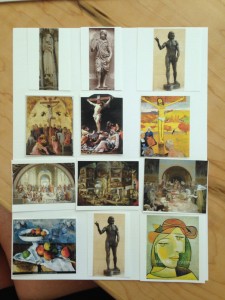The eighth session of the “Art is Us” art history class for Spring 2015 was held on Thursday, May 7. Students brought in “Tribes” puzzles for classmates to solve. Paintings by Harnett and Picasso were compared. We spent extra time on Cézanne, as he is key to understanding modern art. A brief quiz reviewed characteristics of Impressionist and Post-Impressionist periods. The Fauvist and Cubist movements were introduced, featuring work by Matisse, Braque, and Picasso.

Homework assignment
There is no comparison homework assignment this week. Instead, this week’s assignments ask you to look back over what you’ve learned in the last eight weeks, and to consider the current art climate. Optionally, you may create another set of Tribes for your classmates to solve.
[gview file=”https://dicknelsoncolor.com/wp-content/uploads/2015/05/Final-Assignment.pdf”]
Class recap – some key ideas
Tribes puzzles – created by students
Comparison homework discussion
The homework assignment was to compare two paintings, The Old Violin by William Harnett and Violin and Grapes by Pablo Picasso. Listen to the Part 1 audio file, below, for more detail.
Dick provided this general statement:
These two paintings of violins present two opposing views of reality, but share similar concerns for aesthetics.
Harnett takes dictation from an external source, replicating every detail as it appears to the eye. He is guided by life as it appears. Picasso, by contrast, shares with us a more abstract work, as he dissects, reduces and re-assembles forms, leaving the viewer with the essentials; not the particulars. Picasso takes dictation from within.
| Left: Harnett | Right: Picasso |
| External reality Particular violin Particular light source Creativity is in the composition, then replicate appearance with masterful craftsmanship. |
Internal reality Universal violin No particular light source Creativity is in the execution. Countless decisions in a conversation with the emerging work. |
Lecture and slideshow – Post-Impressionism, Fauvism, Cubism
Here are some brief notes on each slide. Listen to the Part 2 audio file, below, for more detail.
- Lecture 7B & 8 title slide
- Comparison assignment: William Harnett & Pablo Picasso (see above)
- Dick’s General Statement for the comparison (see above)
- How Cézanne’s multiple viewpoints depict universal realities
- Cézanne still life
- Analyzing a Cézanne
- Analyze a different Cézanne
- Cézanne paid attention to the background as well as the foreground.
- Landscapes by Cézanne
- Quiz / review of Impressionism and Post-Impressionism
- Lecture 8 title slide
- Fauvism: Wild Beasts! Matisse Woman Reading, Matisse Annelies, White Tulips and Anemones
- Expression? Abstraction? Fantasy? All of the above? Matisse Woman With a Hat
- Matisse in Retrospect
- Cézanne’s Indelible Footprint Leads to Analytical Cubism. Picasso Portrait of Gertrude Stein, Portrait of Daniel-Henry Kahnweiler
- Reflections: More than one side of reality. Manet: Barmaid. Picasso: Young Girl At The Mirror.
- Cézanne’s Genealogy: Braque, Picasso, CUBISM
- Collage: Images begin at the canvas and move forward into real, not perspective space.
- CUBISM: From ANALYTICAL to SYNTHETIC. Picasso? Braque? Woman With Guitar. Picasso Musicians
- Picasso and Braque, the Synthetic Cubism Twins
- REALITY? FACT: Real rope, real wood, real paint. ILLUSION: Imitation chair-caning. Picasso Still Life with Chair-Caning
- 1 + 1 = 3. Seeing a relationship or common denominator in all forms. A synthesis. An assemblage. Two objects in relationship become more than what they were separately. The role of the artist is to see beyond the particulars. Dick said, “Without relationship, art has no meaning for me.” Picasso Bull
- Guernica, Picasso’s Masterpiece. Probably the most famous painting of the 20th century.
- Abstraction, Expression, Fantasy. A universal theme as a memorial to a particular event in history.
From 2009:
Class materials
Audio files
Part 1, slides 1-10: Comparison, Cézanne, Quiz (55:18)
Part 2, slides 11-24: Fauvism (Matisse), Cubism and Collage (Picasso and Braque) (1:03:35)
Part 3: Reflection on the learning experience (2:50)





